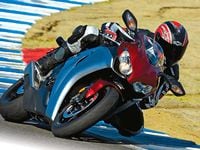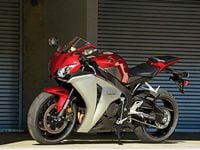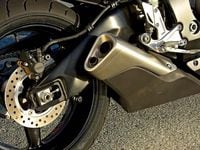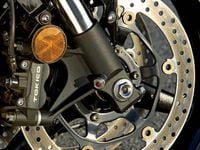2008 Honda CBR1000RR
The formula for success seems simple enough: More power + less weight = pure ownage of the sportbike sector. Such reductive logic can lead straight to failure in the literbike class, though, where development has reached a point where more power or less weight can actually make a bike more difficult to ride quickly. The next revolution in sportbike evolution, then, will be improved rideability. One bike-the remarkable 2008 Honda CBR1000RR-is leading that charge.
That's not to suggest the latest RR isn't more powerful or lighter in weight; Honda claims a 10-horsepower increase, with a corresponding 17-pound decrease in mass. These are just numbers, though. The real story is how that power is delivered, and where that weight is shaved. With genuine technological improvements enhancing power delivery and rider control, and what can only be described as extreme measures to centralize mass and improve handling and stability, Honda delivers the next leap forward in literbike design.
During the press launch at Laguna Seca Raceway in Monterey, California, company officials reported that 23 new patents resulted from the development of this new RR. Significant revisions to signature elements like the Honda Electronic Steering Damper (HESD) and Idle Air Control Valve (IACV) system, as well as the creation of new technology including the Ignition Interruption Control (IIC) that reduces driveline lash and greatly assist off-apex throttle pick-up and a new, dual-action slipper/mechanical-assist clutch, account for most of these advances.
This is impressive, and expected from Honda. More important to overall ability of the bike, however, is the rigorous weight reduction and redistribution program the RR underwent. "Mass centralization," buzzword du jour, has been around since Archimedes described the center of gravity, but with this bike Honda has fetishized the principle. When engineers tell you that even the instrument glass was scrutinized to save weight, you can be sure that nothing was overlooked in the quest to move every possible gram from the edges to nearer the bike's dense core.
Extreme mass centralization has proven worthwhile on Honda's MotoGP racebikes, and it pays similar dividends here. Look closely-except for the 1000cc inline four, this is essentially a street-legal RC212V racer. It's not a coincidence-large project leader for the MFL (Honda's internal code for the CBR1000RR) is Kyoichi Yoshii, whose last title was LPL for the RC211V. This latest RR is surprisingly similar to the current RC212V MotoGP racer. Both bikes were developed essentially side by side with technology proven on the racebikes immediately applied to the CBR.
Start with the new bodywork. The RC inspiration is evident in the blunted nose, deep vertically oriented fairing and abbreviated tail, all of which closely mimic the MotoGP bike's. The radically reduced upper fairing and tail remove pounds from those extremities, and are also said to create more turbulent airflow that improves high-speed directional changes. Every shape is intended to centralize mass and improve transitional handling characteristics. This bike was designed to be functional, and from that function comes unique beauty.
New shapes aren't the only extreme mass-centralizing measure. A new, more compact HESD mounts lower and farther back under the fuel-tank cover, not over the top triple clamp. The new exhaust wraps the length of last year's underseat header around itself and relocates that substantial weight under the bike. Even the new engine was designed with mass centralization in mind; lighter cams and valves in a shorter, narrower cylinder head pull more precious grams toward the center of the bike. Honda staff claim a ready-to-ride curb weight of just 435 pounds. This is 17 pounds less than the 2007 CBR1000RR and, according to Honda, 17 to 35 pounds less than the competition. In a year where other Euro 3-spec literbikes are gaining 8 or 10 pounds, this is a meaningful number.
A more compact (and 2 pounds lighter) battery mounts lower in a frame that is now 1.2 inches slimmer at its widest point. Relocating the battery, along with the smaller engine dimensions, allows the fuel tank to be moved lower in the chassis so the rider could be shifted 2mm closer to the handlebars, which are now 6.5mm higher than before. The new bike is visibly smaller. It feels tiny too, more middleweight than literbike.
This RR steers more like a middleweight too, with surprisingly light, low-effort handling. Big-bore bikes typically take more muscle to turn (to overcome greater engine weight and crankshaft inertia). Not this one. Handling is exceptional, with a confidence-boosting combination of agility and stability-characteristics that are usually mutually exclusive-resulting in a chassis that works as well in Laguna's first-gear Turn 11 as it does in flat-out Rainey Curve. Cornering clearance is excellent as well, even with the new underbike muffler in place. After destroying a pair of brand-new, $360 Alpinestars Supertech boots a few weeks earlier at Qatar on the Kawasaki ZX-10R, we're happy to report we didn't touch toes once on the RR, not even in the G-inducing Turn 6 or Corkscrew.
Corner exits have you wondering whether Honda might have taken too much weight off the RR. Massive power, exceptional rear grip (especially in afternoon sessions, when the standard Dunlop Sportmax Qualifiers were swapped for D211GP Supersport race tires) and an ultra-light front end make the RR a monster on the throttle, with wheelies everywhere in the bottom three gears. The shorter-stroke, internally lightened motor has a lively, almost manic character. And with 6.5 percent more power spread across a broader powerband (thanks to new Dual-Stage Fuel Injection and two exhaust power valves), the latest RR feels plenty fierce ripping through the gears, especially along Laguna's two main uphill straights.
With such a casual relationship between the front tire and tarmac, you quickly learn to love the HESD-technology that every literbike manufacturer should have on license. Traditional steering dampers necessitate compromise. Any setting stiff enough to calm crossed-up, 90-mph corner exits will be too restrictive at parking lot speeds. The HESD relies on an electronic solenoid to adjust damping forces as vehicle speed and acceleration increase, so the damper is undetectable at slow speeds but rock-solid when you're going fast. Headshake is simply not an issue.
HESD isn't the only piece of electro-trickery to love on the '08 RR. The bike is also equipped with Honda's proven Idle Air Valve Control to reduce the effect of engine braking on corner entries, as well as a new Ignition Interruption Control that debuts on this bike, to minimize the effects of driveline lash during acceleration (see "Hard Parts" for a full description). Taken together, the effect is dramatic. The '08 CBR1000RR enters and exits corners with exceptional fluidity and, because engine braking and driveline lash effects are so effectively mediated, offers exceptional chassis stability as well. Mid-corner manners are drama-free as can be, leaving plenty of mental RAM available to concentrate on essential tasks like braking and accelerating.
The final piece of all-new RR technology is a unique dual-function slipper clutch, which limits back torque and incorporates a second mechanism that cams in reverse to assist with forward thrust. This new clutch achieves one goal-lever effort is noticeably lighter-but it could provide more positive engagement. Our bike wasn't the only one to pop out of second gear or miss upshifts into other gears if we failed to fully unload the shift lever first.
We also noted slight brake fade and excess brake lever travel during each 20-minute track session. Engineers on-hand suggested this was the result of brake lines they said were purposefully designed to soften the initial bite of the Tokico four-piston radial calipers, so as not to overwhelm less-experienced street riders. Racers and track addicts will want to fit more rigid lines on their own RRs.
Transmission and brake critiques aside, it's hard not to be impressed with what a complete leap forward the 2008 CBR1000RR represents. Honda realizes this, and as an expression of confidence the company also had 2007 CBR1000RRs available for back-to-back comparisons-virtually unheard of at press launches. I made a few late-afternoon laps on last year's model, which revealed itself as a plus-sized, slow-steering dinosaur by comparison. By the exit of the first turn it was clear: smaller, faster and lighter, with dramatically improved steering and mid-corner stability, the '08 is certainly the best RR ever-and maybe the best literbike yet.
Last year the CBR was the number two-selling literbike, second to Suzuki's dominant GSX-R1000. This latest CBR1000RR was engineered and designed without compromise to raise that position to Numero Uno. Judging from our laps at Laguna Seca, this bike could very well have what it takes.
2008 Honda CBR1000RR | Hard Parts
Motogp Inspiration, Streetbike Application
Electronics
In the ongoing quest to make today's monster-motored literbikes more accessible to mere mortals like us, Honda introduces another electronic innovation: Ignition Interruption Control (IIC). This system engages between 2500 and 6000 rpm to reduce acceleration shock forces (driveline lash), increasing mid-corner stability and smoothness as the throttle is picked up or dropped off. Taking into account both throttle opening and gear selection (each gear has its own preprogrammed profile), IIC uses sensors to compare engine speed with countershaft sprocket speed and, when a speed differential is detected, cuts ignition for just 20 milliseconds at a time to soften the blow. IIC operates in tandem with Honda's Idle Air Control Valve (introduced on last year's CBR600RR), which reduces engine braking by allowing intake air to bypass closed butterfly valves and momentarily elevate engine idle, providing exceptionally smooth transitions when the throttle is opened or closed.
Clutch
One of the more original innovations on the '08 CBR1000RR is the double-action slipper clutch. Exclusive to Honda, this sophisticated clutch not only reduces engine-braking effects under deceleration (like other slipper clutches), but also features a second cam surface that increases force on the clutch plates during acceleration. According to Honda, this provides a more positive clutch engagement and also allows lighter, lower-effort clutch springs to be fitted to reduce effort at the lever. Owing to these advantages, engineers were able to replace '07's hydraulic clutch with a lighter, simpler cable-actuated unit and shave a full pound of weight off the handlebars (a spot far from the center of gravity, natch), without negatively affecting rideability.
Engine
Even the RR engine was subject to Honda's mass-centralization mania, painstakingly redesigned to relocate every last gram as near the center as possible. Last year's integrated cylinder block/crankcase unit has been replaced with a separate cylinder block that does away with ceramic-composite cylinder sleeves in favor of a Nikasil coating applied directly to the cylinder walls. This allows the diameter of the forged, molybdenum-coated pistons to be increased from 75mm to 76mm without increasing overall cylinder width. A shorter-stroke crank (56.5mm to 55.1mm) reduces the overall height of the motor, as does a more compact cylinder head (15mm shorter), enabled by a change to 3mm-shorter exhaust valves and new cams mounted lower in the cylinder head-all for improved mass centralization. A new chilled, thin-wall ductile steel casting process allows camshaft wall thickness to be reduced from 4mm to 2.5mm, saving 1.1 pounds, and new, larger diameter intake valves (29mm to 30.5mm) are now titanium to shave more grams. These myriad changes add up to a remarkable 5-pound weight loss for the engine alone, not to mention a claimed 10-horsepower increase (expect rwhp numbers comfortably in the 160s). Also cutting poundage and centralizing mass is a new multi-chamber mid-muffler with two valves-one operated by servomotor, the other by exhaust pressure-to spread that extra power over an even broader range than before. Still not enough, Speed Racer? A full HRC Superbike power-up kit, said to increase power output by a dramatic 23 percent, will be offered for this bike for the comparatively low price of $30,000.
Chassis
Look at the latest RR stripped naked and you'll see the broadest frame spars in the business, leading to lateral, torsional and vertical rigidity values that have increased this year by 13, 40 and 30 percent, respectively. Not only is the new rack stiffer, but lighter as well, to the tune of 5.5 pounds thanks to a new configuration that utilizes just four hollow, fine-die-cast pieces (compared to nine last year) that are lighter, slimmer and held together with fewer welds. The rear frame section is a single large, U-shaped structure that provides an ultra-rigid anchor point for the massive swingarm, 12mm longer this year for improved stability, with a gullwing-style spar on the right to make room for the underslung exhaust. The kickstand is now sculpted from aluminum to save weight, a bling upgrade from the typical cast-steel shaft. Sweet.
Suspension
At the back we find the latest version of Honda's proprietary, Unit Pro-Link rear suspension. This design mounts the top of the rear shock to the swingarm (not the frame, as on other bikes) to isolate the frame from negative suspension energy and improve rigidity and off-corner drive. A link acting on a rocker arm activates the fully adjustable rear shock; linkage ratios are unchanged for '08, though the spring rate has been optimized. Same for the spring rates in the inverted, 43mm cartridge fork at the front, which features slightly increased offset (from 25mm to 27.5mm) for increased steering stability. The fork is also narrower this year (from 214mm to 204mm), helping contribute to a reduced frontal area and CD that is said to be on par with the typical 250cc GP racebike, according to Honda.
Wheels And Brakes
New, lighter-weight, hollow-spoke aluminum wheels (shaving 8.4 ounces front and 10.9 ounces rear) carry six-button, 320mm rotors that reduce unsprung weight and contribute to mass centralization. Newly designed Tokico monoblock calipers contain chrome-plated aluminum pistons (an upgrade from last year's steel pistons), to save 15 additional ounces. The press kit even calls out "narrower, lighter-weight brake hoses," suggesting just how desperate the diet measures for this new model were.
Tech Spec
Evolution
This all-new model has as much in common with the RC212V MotoGP racer as last year's CBR1000RR.
Rivals
Leading literbikes like the Suzuki GSX-R1000, Kawasaki ZX-10R and Yamaha's YZF-R1.
Verdict
With a stout engine and GP-bike handling, Honda's latest literbike will be tough to beat



















/cloudfront-us-east-1.images.arcpublishing.com/octane/VZZXJQ6U3FESFPZCBVXKFSUG4A.jpg)
/cloudfront-us-east-1.images.arcpublishing.com/octane/QCZEPHQAMRHZPLHTDJBIJVWL3M.jpg)
/cloudfront-us-east-1.images.arcpublishing.com/octane/HXOUJXQWA5HBHGRO3EMJIGFMVI.jpg)

/cloudfront-us-east-1.images.arcpublishing.com/octane/3TIWWRV4JBBOLDVGRYECVVTA7Y.jpg)
/cloudfront-us-east-1.images.arcpublishing.com/octane/KIX5O23D5NAIBGFXBN3327DKZU.jpg)
/cloudfront-us-east-1.images.arcpublishing.com/octane/7GJYDUIPXRGMTMQKN6ONYOLBOU.jpg)
/cloudfront-us-east-1.images.arcpublishing.com/octane/MUQLOVLL2ZDGFH25ILABNBXKTI.jpg)
/cloudfront-us-east-1.images.arcpublishing.com/octane/TNOU5DNE2BC57MFPMGN2EIDXAM.jpg)
/cloudfront-us-east-1.images.arcpublishing.com/octane/GTCXACQGJ5HAPDTGWUQKDEH44E.jpg)
/cloudfront-us-east-1.images.arcpublishing.com/octane/S35YGSEMEZB4BLTDJTSZPF4GLA.jpg)
/cloudfront-us-east-1.images.arcpublishing.com/octane/5UOT6HPX2JFMRJAX6EH45AR4MQ.jpg)
/cloudfront-us-east-1.images.arcpublishing.com/octane/OKWOJWAKP5EP3OACCRRWPCIX2Q.jpg)
/cloudfront-us-east-1.images.arcpublishing.com/octane/2WF3SCE3NFBQXLDNJM7KMXA45E.jpg)
/cloudfront-us-east-1.images.arcpublishing.com/octane/G4MG6OUCJNBSHIS2MVVOTPX65E.jpg)
/cloudfront-us-east-1.images.arcpublishing.com/octane/IIGGWFOTOJGB7DB6DGBXCCMTDY.jpg)
/cloudfront-us-east-1.images.arcpublishing.com/octane/QSTCM6AVEZA5JJBUXNIQ3DSOF4.jpg)
/cloudfront-us-east-1.images.arcpublishing.com/octane/U4I7G625B5DMLF2DVIJDFZVV6M.jpg)
/cloudfront-us-east-1.images.arcpublishing.com/octane/B6XD6LS6IVCQPIU6HXDJSM3FHY.jpg)
/cloudfront-us-east-1.images.arcpublishing.com/octane/ICL63FEDDRDTTMINYICCEYGMDA.jpg)
/cloudfront-us-east-1.images.arcpublishing.com/octane/FCGZHQXRBZFLBAPC5SDIQLVF4I.jpg)
/cloudfront-us-east-1.images.arcpublishing.com/octane/WNOB6LDOIFFHJKPSVIWDYUGOPM.jpg)

/cloudfront-us-east-1.images.arcpublishing.com/octane/X33NU3E525ECRHXLNUJN2FTRKI.jpg)